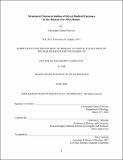| dc.contributor.advisor | Catherine L. Drennan. | en_US |
| dc.contributor.author | Dawson, Christopher Daniel. | en_US |
| dc.contributor.other | Massachusetts Institute of Technology. Department of Biology. | en_US |
| dc.date.accessioned | 2020-09-03T17:48:09Z | |
| dc.date.available | 2020-09-03T17:48:09Z | |
| dc.date.copyright | 2020 | en_US |
| dc.date.issued | 2020 | en_US |
| dc.identifier.uri | https://hdl.handle.net/1721.1/127128 | |
| dc.description | Thesis: Ph. D., Massachusetts Institute of Technology, Department of Biology, May, 2020 | en_US |
| dc.description | Cataloged from the official PDF of thesis. | en_US |
| dc.description | Includes bibliographical references. | en_US |
| dc.description.abstract | Anaerobic bacteria play important roles in the human gut microbiome and have dedicated chemical pathways for growth in the absence of oxygen. Glycyl radical enzymes (GREs) use an oxygen-sensitive glycyl radical cofactor to perform challenging, radical-based chemistry. Generation of this cofactor requires a dedicated GRE-activating enzyme (GRE-AE). This thesis presents structural analysis of one GRE involved in sulfur metabolism, structural and biochemical analysis of another GRE involved in nucleotide metabolism, and efforts towards structural characterization of a GRE-AE. C-S bond cleavage of isethionate by the GRE isethionate sulfite-lyase (IslA) generates sulfite, a substrate for sulfite respiration that in turn produces the disease-associated metabolite hydrogen sulfide. In this thesis, I present and describe an X-ray crystal structure of IslA from Bilophila wadsworthia with isethionate bound. | en_US |
| dc.description.abstract | In comparison to other GREs, IslA uniquely positions active site beta strands and residues to create a highly tailored active site for the binding of the negatively charged isethionate substrate. Through kinetic analysis of thirteen site-directed IslA variants, we probe the mechanism by which radical chemistry is used for C-S bond cleavage. This work further elucidates the structural basis of chemistry within the GRE superfamily towards structure-based inhibitor design of IsIA and thus of microbial sulfide production. Another GRE, anaerobic ribonucleotide reductase (NrdD), which creates the subunits necessary for DNA replication and repair, is often regulated to prevent deleterious effects to the microbe. I describe unpublished structural data of a NrdD from Steptococcus thermophilus (StNrdD) and present data that suggests this activity regulation may involve certain intramolecular conformational changes. | en_US |
| dc.description.abstract | The StNrdD activating enzyme (StNrdG) appears to lack essential features of a GRE-AE and presents an interesting structural case study for understanding glycyl radical activation. I present purification and reconstitution protocols for StNrdG and discuss efforts towards crystallization. Altogether, this work explores the wide diversity of chemical reactions afforded by the GRE fold to enable anaerobic bacteria to perform fundamental chemical transformations. | en_US |
| dc.description.statementofresponsibility | by Christopher Daniel Dawson. | en_US |
| dc.format.extent | 158 pages | en_US |
| dc.language.iso | eng | en_US |
| dc.publisher | Massachusetts Institute of Technology | en_US |
| dc.rights | MIT theses may be protected by copyright. Please reuse MIT thesis content according to the MIT Libraries Permissions Policy, which is available through the URL provided. | en_US |
| dc.rights.uri | http://dspace.mit.edu/handle/1721.1/7582 | en_US |
| dc.subject | Biology. | en_US |
| dc.title | Structural characterization of glycyl radical enzymes in the human gut microbiome | en_US |
| dc.type | Thesis | en_US |
| dc.description.degree | Ph. D. | en_US |
| dc.contributor.department | Massachusetts Institute of Technology. Department of Biology | en_US |
| dc.identifier.oclc | 1191837175 | en_US |
| dc.description.collection | Ph.D. Massachusetts Institute of Technology, Department of Biology | en_US |
| dspace.imported | 2020-09-03T17:48:09Z | en_US |
| mit.thesis.degree | Doctoral | en_US |
| mit.thesis.department | Bio | en_US |

